|
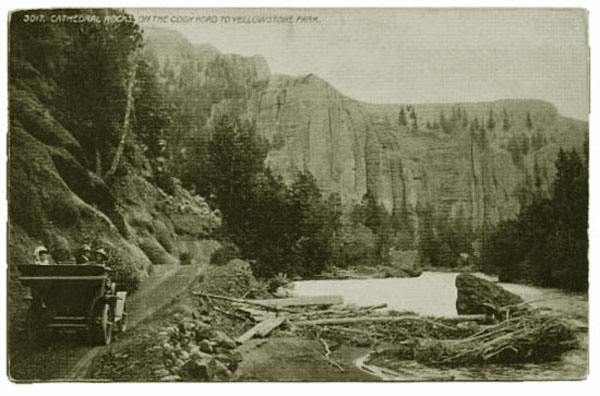
Cody Road to Yellowstone, Cathedral Rock.
Approximately forty miles west of Cody, is Goff Creek named after early guide, John B. Goff, who
operated a small lodge between 1906 and 1912. Goff is most noted as being one of Theodore Roosevelt's favorite
guides and having received a contract to exterminate mountain lions from Yellowstone.
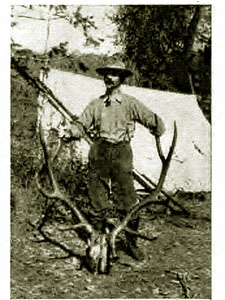 John Goff
John Goff
|
Goff originally came to prominance as a guide when he acted as a guide to Roosevelt in 1901.
Goff acted as then Vice-President elect Roosevelt's guide on a hunting trip near Meeker, Colorado, where
Goff maintained a ranch. The trip had established Roosevelt's reputation as a hunter. The
New York Times, February 17, 1901, reported the results of the hunt:
COL. ROOSEVELT COMING EAST.
_________________
Killed Twelve Mountain Lions, Among
Them One Weighing 227 Pounds.
MEEKER, Col., Feb 16.--Vice President-elct Roosevelt and John Goff rode into Meeker from the
Keystone Ranch last night having concluded their hunt for big game in the mountains. When asked for interviews Col. Roosevelt referred the
correspondent to Mr. Goff. Mr. Goff said seventeen lions were killed during the hunt and that the Colonel himself killed twlve, four with his knife and
eight with his rifle. Mr. Goff further stated that Col. Roosevelt killed the largest lion that has been killed in this section,
wighing 227 pouunds and measuring 81/2 feet in the flesh. Mr. Goff states that Col. Roosevelt killed
it with his knife.
One of the most exciting experiences of the hunt occurred when Col. roosevelt killed his
second largest lion. In order to get a shot the Colonel leaned the larger portion of his
wighty body over a cliff forty feet high. Goff held him by the leg. The Colonel brought down his
game with the first shot. Col. Roosevelt expressed himself as having
the most enjoyable time of his life. He will leave Meeker to-day in a
special conveyance. He will take the train to-night at Rifle, when he probably will go home.
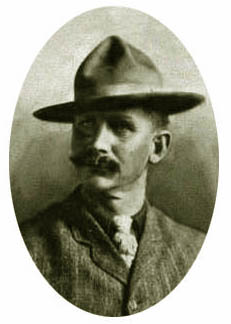 John Goff
John Goff
|
While, Goff's reputation was made, Col. Roosevelt was soon to realize that hunting created political problems.
Thomas Edison produced a movie satire of the hunt in which Col. Roosevelt was shown as stabbing a small stuffed cat while a reported and cameraman recorded every
moment. In fact, Edison's satire proved to be prescient of Roosevelt's next hunt. In 1902, Roosevelt again
proposed to return to Colorado for another hunt with Goff. In the meantime, however, President McKinley had erred by
visiting Buffalo, New York, and Roosevelt discovered that time would not allow the visit to Colorado. Instead, a bear
hunt in Mississippi became the consolation prize. There as the President stalked bear, the press and onlookers
stalked the President's very move, literally stepping on Roosevelt's heels. Thus, no wild bear was spotted.
Some eager spectators, anxious to see the President shoot a bear, tied a sickly old bear to a tree. Col. Roosevelt
refused to shoot the bear. Nevertheless, the President was then satirized by a cartoon in the
press and the marketing of stuffed toy bears, allegedly giving rise to the name "teddy bears." Another version, however,
to the term teddy bears is that they originated as a result of a subsequent 1906 unsucessful hunt in Colorado with
Jake Borah acting as chief guide. Goff had in the meantime moved to Wyoming. The 1906 hunt was a failure and maids at the
Colorado Hotel gave Roosevelt a stuffed toy bear giving rise to the name "teddy bear."
In 1903, Roosevelt again proposed to return to Colorado, but Roosevelt's political advisors recommended against it.
Instead, he made his politically and environmentally correct 1903 trip to Yellowstone.
Goff was famous for his packs of dogs, some of which could actually pursue their quarry up trees. In 1905, Roosevelt returned to
Colorado and used Goff as a guide. Most of the dogs were hounds except one smaller terrier named "Skip." Roosevelt wrote his son Ted:
We have about thirty dogs, including one absurd little terrier about half Jack's size, named Skip. Skip
trots all day long with the hounds, exceting when he can persuade Mr. Steward or Dr. Lambert, or me to take him up for a ride, for
which he is always begging. He is most affectionate and intelligent, but when there is a bear or
lynx at bay he joins in the fight with all the fury of a bull dog, though I do not think he is much
more effective than on of your Japanese mice would be. I should like to bring him home for Archie or Quentin. He
would go everywhere with them and would ride Betsy or Algonquin.
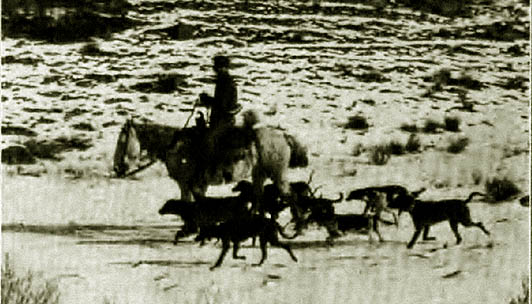
John Goff and his dogs.
Goff gave the President Skip. The White House at the time was replete with mice and rats. Skip soon made short
work of them. Ultimately as a result, terriers similar to Skip became known as rat terriers. In the
Roosevelt household, Skip learned to ride one of the children's ponies by himself and would go sailing with
Archie on Long Island Sound.
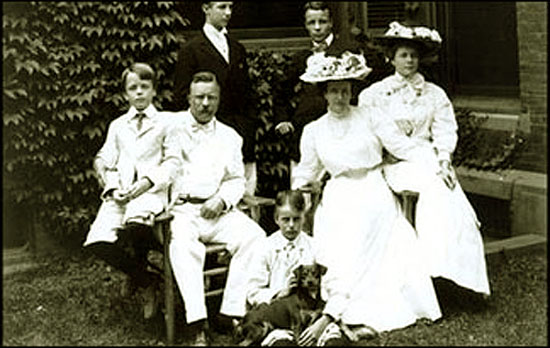
Skip sitting on Archie Roosevelt's lap.
Skip died in 1907 and was buried behind the White House. In 1908 before Roosevelt left office, Edith Roosevelt had
Skip disinterred and buried at Sagamore, the Roosevelt home on Long Island.
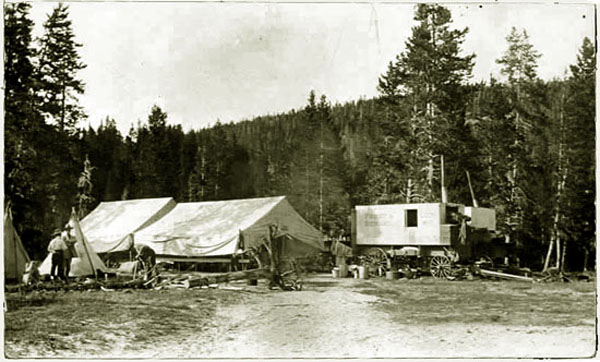
Frost and Richard Company Camp.
Col. Cody, Tex Holm, and John Goff were not the only ones to provide guide service along the North Fork of the
Shoshone. Ned W. Frost and Fred J. Richard also established a camping business about 1909. Their headquarters was about 20 miles west of
Cody. Both were noted guides. Richard acted as the hunting guide of Prince Albert of Monaco in his
1913 visit to the area.
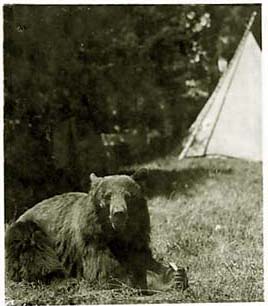 Bear outside tent. Photo by
Ned Frost. Bear outside tent. Photo by
Ned Frost.
Prior to the opening of the Cody Road, Frost had guided tourists into Yellowstone from
Cody taking them through the Sunlight Basin over the difficult Dead Indian Hill to Cooke City, Montana. Part of the
route required the wagons to be tried to trees with spring lines to prevent them slipping off the
trail down the precipice below. Frost acted as a guide for Saxton Pope author of the 1923 Hunting with Bow and Arrow.
In 1917, Frost was guiding a group in Yellowstone. At the campfire he told the campers that there was no
danger from grizzly bears. That night, a grizzly invaded the tent which Frost was sharing with
a horse wrangler named Jones and mauled both. Both survived. The year before in 1916, Richard with a cook named
Jones was mauled by a grizzly. Additionally, in September of that year, a party of three employed by the
United States engineers were attacked by a large grizzly. The bear was killed the next day with
dynamite. For the remainder of his life, Frost had a dislike for grizzlies and reportedly killed
about 500 of them.
One of Frost's most memorable hunting parties was the 1913 thirty-three day hunting expedition undertaken on behalf of
New York millionaire Charles G. "Spend-a-million" Gates. Gates had hoped to get to Cody in time to join
Prince Albert's party but was delayed enroute. Gates' expedition was into the Lamar Valley and into the
remote Thorofare Country in the Avsarokas southeast of Yellowstone. Gates had inherited his fortune from his father, John W. "Bet-a-Million" Gates,
the barbed wire king. It was estimated that he gave away $1,000,000 in tips each year. He certainly did not
fail Ned Frost awarding him, according to the New York Times, a $10,000.00 tip. On October 28, 1913, Gates arrived at the
Cody depot where where his private railway car, the Superb, awaited. His retinue included two personal physicians. The wagons which
followed him to the railway station carried in addition to his luggage
the crated heads of 10 bull elk and five deer. He told
newspaper reporters who were covering his departure, that he would return the following year. "This is
the greatest big-game country on the globe," he said.
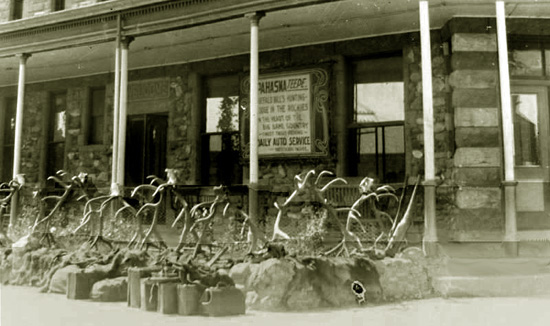
Tropies and luggage in front of the Irma Hotel awaiting
transport to the railway depot, approx. 1913.
Gates continued telling the reporters: "Henceforth it will be my happy hunting ground." He then fell into a convulsion of
apoplexy and, notwithstanding the immediate attention of his physicians, was dead within ten minutes. There were later rumors that
37-year old Gate's death was brought about by either a botched prescription or by his having engaged in a drinking match with
Col. Cody. Gates had, however, been in poor health before his trip west and the trip was prescribed in the hopes
that the clear Wyoming air would cure his ailments.
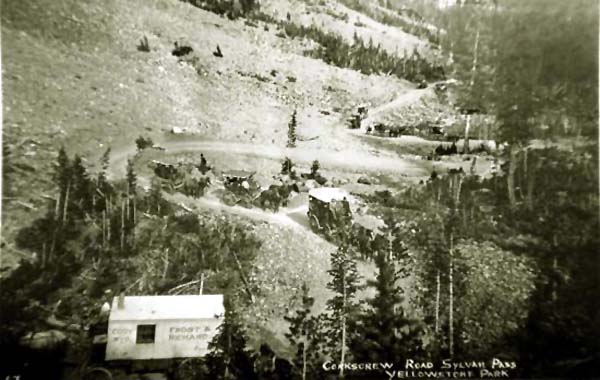
Frost and Richard Camping Train ascending Cody Road near Sylvan Pass.
It has been rumored in the Cody area that Ned Frost and Fred Richard following Col. Cody's death and funeral sneaked into
Olinger's Mortuary and switched the unclaimed body of a cowboy for that of Col. Cody. They then
allegedly returned Col. Cody's body to Cedar Mountain.
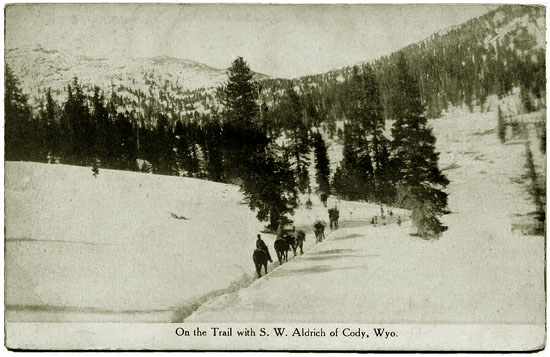
On the Trail with S. W. Aldrich.
Samuel "Sam" W. Aldrich, a stockman, was also an early guide into Yellowstone. Caroline Lockhart satarized
Sam as having spurs that could be mistaken for "phonygraph records." Miss Lockhart, herself, however, wore spurs into
her newspaper office. His ranch was located
about 20 miles west of Cody on the South Fork of the Shoshone. Another early guide was
Joseph Jones.
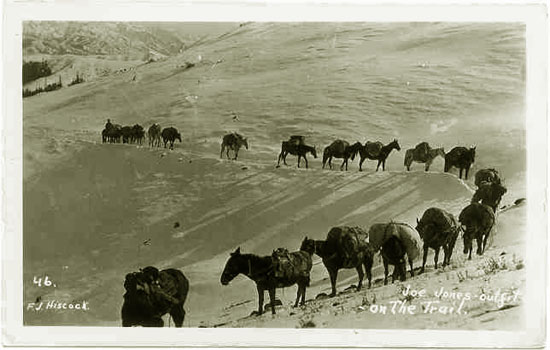
Joe Jones pack team. Photo by F. J. Hiscock.
Next Page: Cody Road Continued.
|